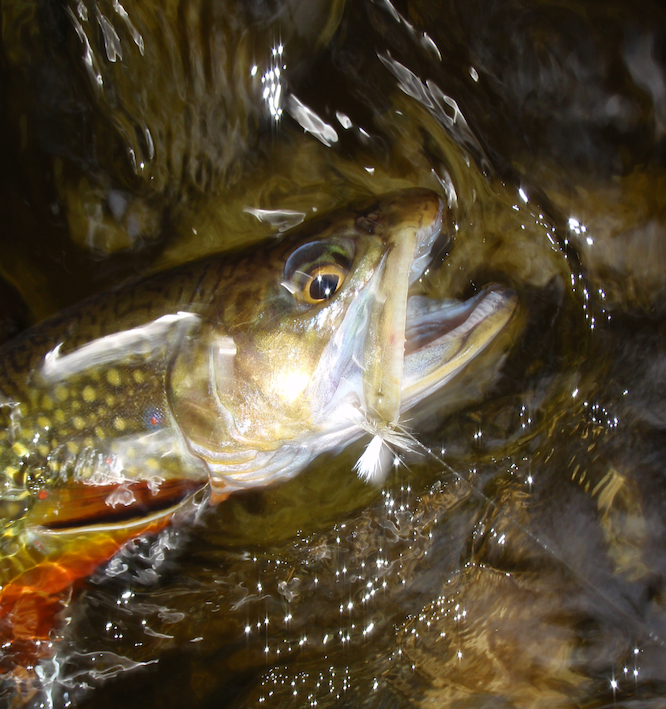The brook trout is actually char, native to Appalachia, eastern Canada and the upper Midwest. Photo by Chris Hunt.
Editor’s note: This the third in a series of posts geared toward new fly fishers. More installments will follow.
A couple of years ago, I was fishing a small, backcountry trout stream on the Island Park Plateau, just west of the boundary with Yellowstone National Park in Idaho. I’d fished it many times before, and I’d never seen another angler. Until that day.
As I bushwhacked my way up the stream I was surprised to come upon a younger angler who was tossing small spinners into the current and doing quite well—attached to his hip was a nearly full stringer of small, but respectable, brook trout.
We stopped and chatted for a bit, and he asked how I’d been doing. I had caught and released a lot of brookies—not unlike the fish he’d harvested (legally, I might add)—and a couple of respectable rainbows.
“I hope you’re not offended that I’m keeping all these native brookies,” he said to me.
First, of course not, I told him. Harvesting brook trout here in the West is actually a good thing on many trout streams—and Idaho offers a very liberal harvest limit. Second, I told him, brook trout aren’t native to this stream, or any other stream in the West—brookies are native to Appalachia, the upper Midwest’s Driftless Area and the lakes and rivers of eastern Canada.
“That so?” he asked. “The were hatched right here. Doesn’t that make them native?”
I explained to him that the “native” fish to this stream would have been Yellowstone cutthroat trout. The wild brookies he and I were catching were likely introduced close to 100 years ago, and, over time, they outcompeted the native trout.
“What about the rainbows?” he asked.
“Native to California and the Pacific Northwest,” I said. “They’re not from here, either.”
He seemed confused. I offered to give him the full run-down on where all the non-native fish in the area came from, but he, thankfully, passed on the chance. He was grateful for the information—or at least he said so—and we parted ways, heading in opposite directions. I hopped up on the game trail next the creek and humped it upstream a half a mile or so to get into water he likely hadn’t fished yet, and he wandered on downstream.
Trout in America aren’t always what they seem. Thanks to more than a century of hatchery science, a lot of our native trout are gone from their home waters, replaced by more “desirable” fish by fisheries managers decades ago. To their credit, most state fish and game departments are doing their best these days to right past wrongs, but we’ll likely never have native fish in historic numbers again. Ever. But that doesn’t mean it hurts to know where native trout belong.
Here’s a really basic primer:
- Brook trout are native to the eastern U.S. and eastern Canada, as well as to the Great Lakes region and the Driftless Area of the upper Midwest. Brookies are actually a char, not a trout. They are related to the native char of the West, the bull trout, the Dolly Varden and the Arctic char. They have been propogated all over the country, and today, might be the most numerous trout in the United States … but in their native waters in Appalachia, they populate only a small portion of their historic waters. They are threatened by non-native species, habitat loss and climate change. You can identify brookies by the worm-like markings on their backs. And, in the fall, when they spawn, they take on truly glorious colors. One tip: Telling the difference between trout and char is easy. Trout have dark spots on light bodies. Char have light spots and markings on dark bodies.
- Cutthroat trout are native to West, and there are several subspecies, ranging from the Rio Grande cutthroat trout in southern Colorado and northern New Mexico to the coastal cutthroat trout that can be found along the Pacific coast from California north to Alaska. Today, cutthroats occupy a small portion of their native waters. They are a true trout, they spawn in the spring and they can be identified by the tell-tall red slash beneath their jaws.
- Rainbow trout are native to the Pacific coast, from the small streams of the Angles National Forest in California all the way north the salmon waters of Bristol Bay, Alaska. Rainbows are now wild and naturalized all over the country (and all over the world, frankly). Rainbows are spring spawners and they can be identified by the strip along either side that can range between deep red to light pink.
- Brown trout are native to Europe. A lot of people call brown trout “German browns,” but that’s only partly true. While the first browns introduced to America in 1883 were of the Von Behr strain from Germany, other browns from Scotland’s Loch Leven also found their way to the U.S., and I suspect still other strains of brown trout have made their way here, too. Browns are fall spawners and their appearance can vary greatly. For the most part, though, they are a deep, buttery yellow (particularly when spawning) and feature black spots and, closer to the belly, red spots and markings.
These are the “big four,” but this barely scratches the surface. If you’re really interested in getting to know the fish you’re after, check out Dr. Rober Behnke’s book, “Trout and Salmon of North America.” It’s an exhaustive primer that might leave you scratching your head, but if the topic is interesting to you, it’s a great book on which you can geek out on trout. Trust me. I’ve done it.
— Chris Hunt
Other installments:



